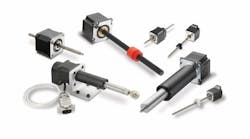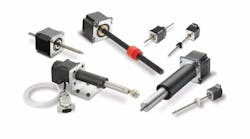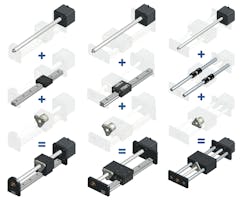DIY or Collaborate? Navigating the Path to Optimal Linear Actuator Guidance
When machine designers need to translate motor torque into linear thrust, they often specify a stepper motor with an integrated lead screw and nut. Known as a stepper motor linear actuator (SMLA), this configuration can provide precise control, reliability and versatility along a linear path, but if there is potential for even a small moment or side load, it will be necessary to add additional linear guidance. A well-designed guidance mechanism can prevent any binding, bending, buckling or other dysfunction that side loading might introduce.
On the surface, adding guidance to an SMLA appears to be so easy that it may tempt experienced engineers to design it themselves, but given the complexity of calculations that may be involved, in even the smallest applications, the DIY strategy might not be worth the risk. Determining what is right for any application requires careful consideration of the motion profile, available time and budget, space considerations, integration and support.
Why SMLAs?
An SMLA typically consists of a stepper motor and an integrated lead screw that moves a load in a back-and-forth linear motion. SMLAs are highly reliable, economical workhorses that drive numerous applications in which precise stopping and starting and high programmability are desired, such as microscope stage adjustments, 3D printer head movement and pipetting (Figure 1).
The Need for Guidance
An SMLA provides thrust along a linear axis but cannot tolerate side loading. Undesirable loading perpendicular to this axis can result from any of the following factors:
- Bending moment force from misaligned loads
- Vibration and shock loads, especially in environments with mechanical impacts or oscillations
- Thermal expansion differences among components
- Gravity
Such forces, independently or in combination, can wear out or deform components. They can cause bending and buckling, premature failure and increased stress on bearings or lead screw nuts and threads. Misalignment, increased friction and material fatigue also contribute to overall performance degradation and shorter system life.
READ MORE: Cut Time and Costs by Customizing Motion Control Systems with Standard Components
Avoiding the negative impact of moment or side loads requires supplemental guidance to protect against external forces impacting the linear motion of the load. Guidance often involves deploying additional round or square rails and bearings external to the lead screw. The challenge for either the user or OEM is to determine the most robust guidance, in the smallest space and at the lowest cost.
Adding the Guidance
The larger the load and the higher the speed, the more complicated it is to add guidance in an optimal way. The following steps are involved:
- Assessing the spacing, budget and delivery parameters
- Determining whether round rail, square rail or another guiding mechanism is best
- Running optimization calculations, which can take days
- Implementing the final design in CAD
- Assembly
- Testing
It is sometimes possible to put together a compact linear motion system from off-the-shelf components by yourself, integrating thrust and guide rails in a single, small-scale unit. However, an additional degree of expertise is usually needed to arrive at the optimal solution. Machine designers are left to choose between assembling a linear motion system themselves, potentially with unknown risks, or relying on a motion control manufacturer with decades of application expertise to create a highly configured solution, most often available with standard components.
Do it Yourself?
Designing a compact linear motion system by yourself can result in a more bespoke solution at a lower cost and could bring economies of scale in high-volume applications, but there are many potential downsides as well.
Machine designers who do not have extensive experience with system design may err on the side of caution and overengineer. While overengineering might reduce risk, it usually adds complexity as well. For example, oversizing the rails would add more support but would also add costs and eat up space. It is not uncommon for engineering projects to fail in their first iteration, which can entail going back to square one, adding further costs and delays.
READ MORE: Getting the Right Stepper or Servo Motor for Electric Actuators
Many, if not most, DIY projects integrate components from different vendors, which are less likely to work together optimally. If there is a problem, there may be finger-pointing among the component suppliers. Likewise, maintenance and support could be an issue, especially if the original in-house design team is no longer available to complete the project.
Partnering for Success
Working with a vendor who can configure the “just right” assembly of standard or slightly modified components will help to avoid such problems. Vendors are more likely to have extensive experience in customizing linear motion systems for diverse applications. Vendors may have developed configuration specifications, CAD models and online tools that facilitate the process, as well as physical tools that enable them to machine parts more efficiently. Vendors also may have pre-tested modules that can be adapted easily without major customization (Figure 2). Modularity allows vendors to deliver highly configured standard products without the added cost normally associated with custom products.
Vendors also take responsibility for the operation of the product—usually by issuing warranties. If integrated at the factory, the designer can be more confident that there will not be mismatches among components. Vendors will also have the experience to make maximum use of minimal space, producing a more compact linear motion system. Some suppliers provide customization services for free. The outcome of these vendor benefits and capabilities is less time, headaches and maintenance, a quicker solution and, most importantly, a lower total cost of ownership.
READ MORE: Getting the Right Motor
The Safe Choice
If you need to customize a high-volume linear motion system project, have available time and expertise, and can tolerate some risk, you may be able to reduce the cost of having a guided system by building it yourself. Otherwise, working with an experienced vendor’s engineering team to assemble a highly configured, compact linear motion system from standard components for your application may get you the optimized product you need faster and with less risk.
Although short-term, out-of-pocket costs may be higher, when you take all factors into account, working with an experienced linear motion supplier will result in a higher-quality, quicker solution with maximum ROI.
This article was submitted by Matt Palmer, product manager – Linear Units, Thomson Industries, Inc.



